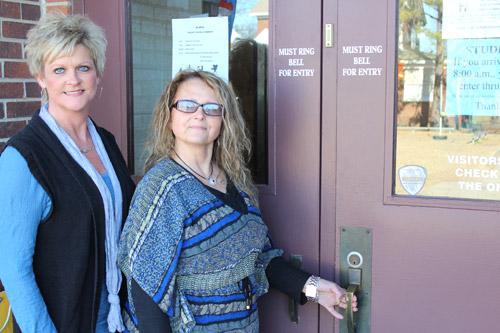

The school day was just beginning when the phone rang in the office of St. Paul School in Pocahontas late last year. First-year principal Maria Dickson remembers the message clearly.
“Lock down your school,” said the 911 operator on the other end.
“They told me that there was a person with a gun and he was headed to one of the schools in town, but they didn’t know which one,” she said. “I went to each classroom and quietly told the teachers to stay inside, not to take their kids out or to let any kids go out by themselves.
Less than two hours later, 911 gave the all clear; the apprehended suspect was never on school property. Dickson, who grew up in Pocahontas and attended St. Paul School, is nonchalant retelling the story.
“It really wasn’t too bad,” she said. “I know we have a very safe school here. Our town is a sleepy little town. But then, so was Newtown.”
The December murder of 20 first graders and six teachers in their Connecticut classroom still reverberates in the halls of legislatures debating tougher gun laws and in the minds of educators as they re-examine their security measures and emergency action plans. The Diocese of Little Rock is no different.
“The safety of students is a constant weight on the minds of principals,” said Vernell Bowen, diocesan superintendent of schools. “It’s something teachers think about, but it’s something that is a principals’ number one responsibility. They all know it comes with the territory.”
Arkansas Catholic polled diocesan school principals on how parochial schools are staying prepared against emergencies. Principals said their main safety concern was natural disasters (47 percent), followed by intruders (33 percent).
Among the 17 respondents, 94 percent reported requiring parents and visitors to sign in at the office, 70 percent require visitors to wear name badges and 77 percent lock all exterior doors including the front door.
However, only 50 percent keep classroom doors locked and 41 percent have security cameras on all exterior doors.
Bowen said improving physical plant security is often hindered by lack of funds. Schools must pay for new locks, cameras and other security measures out of their operating budgets. Additional diocesan funds are limited to a small pool made available through Catholic Arkansas Sharing Appeal contributions, from which principals may apply for grants.
However, as Newtown illustrated, investing in more technology isn’t failsafe. Sandy Hook Elementary School had just installed a new security system last fall but it didn’t stop an intruder from shooting his way into the building. What limited the loss of life, experts point out, was the manner in which teachers followed emergency protocols.
Bowen said this is the area of focus for Arkansas’ parochial school administrators and has been even before the Newtown incident. Months earlier, Bowen circulated templates for crafting an emergency action plan for those who didn’t have one and urged revision of those already in place.
Marcia Diamond, principal of St. Joseph School in Fayetteville, has honed her emergency communications such that a letter to parents was drafted and posted online shortly after the morning’s first reports on Newtown. She said all tragedy aside, Sandy Hook provided a compelling case study against which her own school’s protocols could be measured.
“We drew lessons from Newtown, just as we drew lessons from Joplin (tornadoes),” she said. “The point is, in every situation, to say, ‘If that were us, what would we do?’ It would be wrong for us not to use them to evaluate our own readiness.”
Since school reconvened after Christmas break, Bowen has scheduled webinars for principals on security topics and is partnering with school security experts to offer best practices at an in-service meeting with principals next month. More than having a plan, she stresses practicing it through regular drills as with other emergencies.
“Lockdown” or intruder drills, where the classroom doors are locked and the students are positioned on the floor away from windows and doors, are held regularly in 65 percent of the schools. The remaining schools surveyed admitted they plan to conduct them soon. Bowen, however, said intruder drills are not required but that guideline might change.
“Schools are already required to hold monthly fire drills and two tornado drills per year,” she said. “It’s important that students and teachers know what to do and where to go regardless of the situation.”
Denise Troutman, a principal for 19 years, knows firsthand what it means to have threats on multiple fronts. As principal for North Little Rock Catholic Academy, she buttresses her school against a rough neighborhood, the occasional parent who came out on the wrong end of a custody battle and potential chemical spills in a derailment of a nearby train.
“I’ve met with the mayor, the chief of police and a member of the city council,” she said. “They want to clean up this area, and I made sure they knew that we are a stabilizing force in the community, and we need their support.”
Bowen, Troutman and Diamond all said they don’t favor arming teachers or principals. They cite difficulty in securing firearms and the distraction guns would present in the classroom. Dickson, a mother of two elementary students, isn’t so sure.
“Depending on the school system, I think it’s a good idea,” she said. “We don’t need it in my school, but with only women here, we do need a way to protect ourselves. If I was trained properly, I could and would protect my students and my staff.”
Please read our Comments Policy before posting.
Article comments powered by Disqus 'Cabrini' film tells story of saint with great faith
'Cabrini' film tells story of saint with great faith
 Bishop Taylor announces more pastoral appointments
Bishop Taylor announces more pastoral appointments
 Most U.S. Catholics approve of Pope Francis, Pew says
Most U.S. Catholics approve of Pope Francis, Pew says
 Winning directory photo honors Our Lady of Guadalupe
Winning directory photo honors Our Lady of Guadalupe
 St. Joseph a model of solidarity with immigrants
St. Joseph a model of solidarity with immigrants
 Two gifts after Jesus’ death: Virgin Mary and Eucharist
Two gifts after Jesus’ death: Virgin Mary and Eucharist
 Why we have an altar, and not just a communion table
Why we have an altar, and not just a communion table
 Pope: Wars should be resolved through nonviolence
Pope: Wars should be resolved through nonviolence
 Living relationship with Jesus Christ in the Eucharist
Living relationship with Jesus Christ in the Eucharist